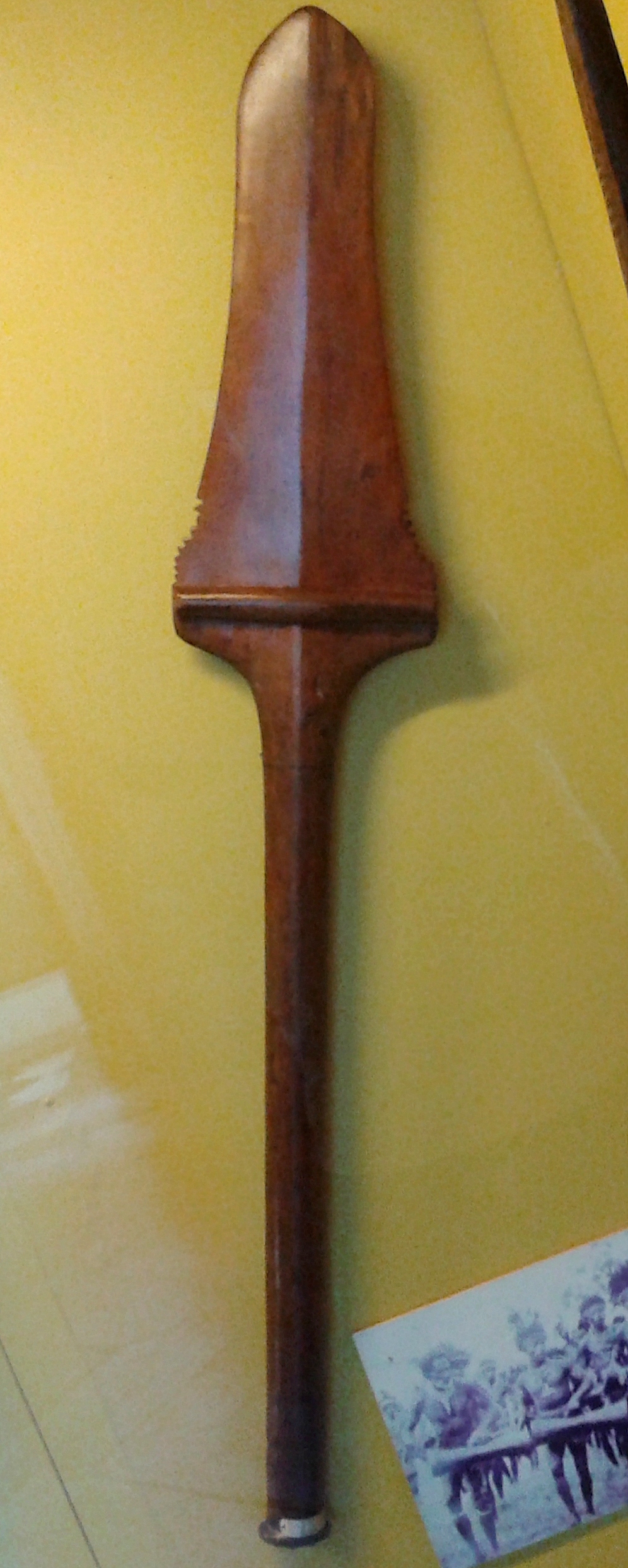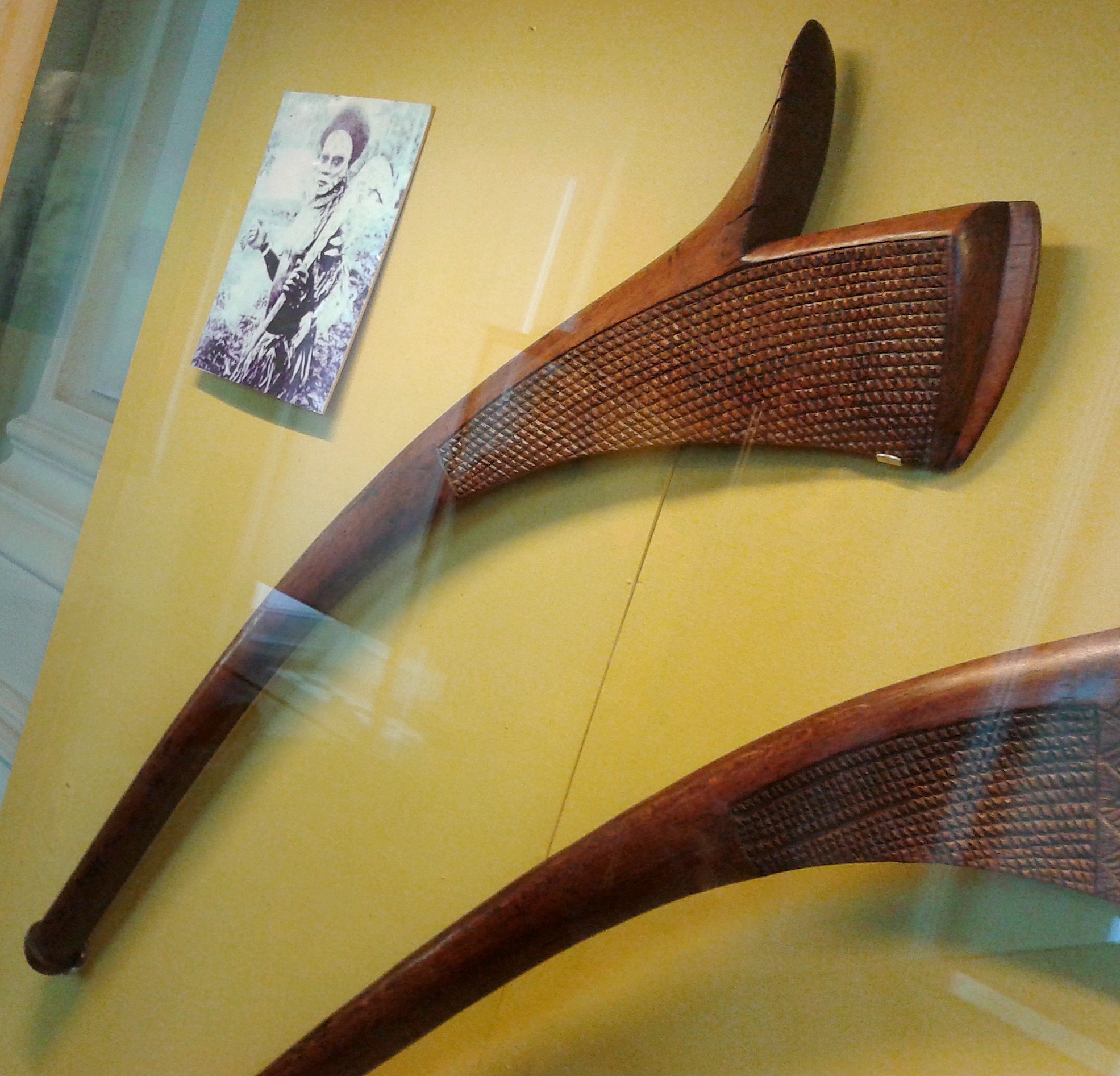|
Totokia
The ''totokia'' (also pineapple club or beaked battle hammer) is a type of club or battlehammer from Fiji.Eric Kjellgren, How to Read Oceanic Art' ( Metropolitan Museum of Art/ Yale University Press, 2014), p. 153. The ''totokia'' was called the "pineapple club" because of the spiked ball behind the weapon's beak.Ron Ewins, "The Perils of Ethnographic Provenance: The Documentation of the Johnson Fiji Collection in the South Australian Museum" in ''Hunting the Collectors: Pacific Collections in Australian Museums'' (eds. Susan Cochrane & Max Quanchi: Cambridge Scholars Publishing, 2007), p. 62. The name is a misnomer; the shape actually is modeled after that of the fruit of the ''pandanus''. The spike ("beak") and head of the weapon were used to puncture the skull of the enemy and crush the head. In addition to its functional use as a weapon of war, ''totokia'' were also status symbols. [...More Info...] [...Related Items...] OR: [Wikipedia] [Google] [Baidu] |
Culacula
A Culacula is a paddle war club from Fiji. Uses in Fiji Usually cut from a hardwood type of iron wood, it has a broad blade and was used by chiefs or priests to deflect arrows during war.Susan Cochrane, Max Quanchi Max Quanchi is an Australian academic whose research specialisations have been the South Pacific nations and the role of photography in recording and transmitting its cultures and histories. Biography Quanchi was born in Victoria on 20 June 1945 ..., ''Hunting the Collectors : Pacific Collections in Australian Museums'', 2014, p. 4/ref> Bibliography * Fergus Clunie, ''Fijian Weapons & Warfare'', 2003. * Jean-Edouard Carlier, ''Archipels Fidji - Tonga - Samoa: La Polynésie Occidentale'', Voyageurs & curieux, 2005. * Rod Ewins, ''Fijian Artefacts: The Tasmanian Museum and Art Gallery Collection'', Tasmanian Museum and Art Gallery, 1982. References See also * Totokia * Gata * Sali * Ula * Bulibuli Throwing clubs Clubs (weapon) Primitive weapons ... [...More Info...] [...Related Items...] OR: [Wikipedia] [Google] [Baidu] |
Club (weapon)
A club (also known as a cudgel, baton, bludgeon, truncheon, cosh, nightstick, or impact weapon) is a short staff or stick, usually made of wood, wielded as a weapon since prehistoric times. There are several examples of blunt-force trauma caused by clubs in the past, including at the site of Nataruk in Turkana, Kenya, described as the scene of a prehistoric conflict between bands of hunter-gatherers 10,000 years ago. Most clubs are small enough to be swung with one hand, although larger clubs may require the use of two to be effective. Various specialized clubs are used in martial arts and other fields, including the law-enforcement baton. The military mace is a more sophisticated descendant of the club, typically made of metal and featuring a spiked, knobbed, or flanged head attached to a shaft. Examples of cultural depictions of clubs may be found in mythology, where they are associated with strong figures such as Hercules or the Japanese oni, or in popular culture, wh ... [...More Info...] [...Related Items...] OR: [Wikipedia] [Google] [Baidu] |
War Hammer
A war hammer (French: ''martel-de-fer'', "iron hammer") is a weapon that was used by both foot soldiers and cavalry. It is a very old weapon and gave its name, owing to its constant use, to Judah Maccabee, a 2nd-century BC Jewish rebel, and to Charles Martel, one of the rulers of France. In the fifteenth and sixteenth centuries the war hammer became an elaborately decorated and handsome weapon. The war hammer was a popular weapon in the late medieval period. It became somewhat of a necessity in combat when armor became so strong that swords and axes were no longer able to pierce and ricocheted upon impact. The war hammer could inflict significant damage on the enemy through their heavy impact, without the need to pierce the armor. Design A war hammer consists of a handle and a head. The length of the handle may vary, the longest being roughly equivalent to that of a halberd (5 to 6 feet or 1.5 to 1.8 meters), and the shortest about the same as that of a mace (2 to 3 feet or 60 ... [...More Info...] [...Related Items...] OR: [Wikipedia] [Google] [Baidu] |
Sali (weapon)
A Sali or Cali or Tebetebe is a war club from Fiji. Uses in Fiji Usually cut from a hardwood type iron wood it is intended for war. It differs from the Gata by the width of its striking head. It is named Sali because of its resemblance to the clawed flower of the plant of the same name (Sali) of the genus Musa of the banana family.Anthony JP Meyer, ''Art océanien'', Könemann, 1995, p. 473 See also * Totokia * Ula * Gata * Culacula * Bulibuli References Bibliography * John Charles Edler, Terence Barrow, ''Art of Polynesia'', Hemmeter Publishing Corporation, 1990. * Rod Ewins, ''Fijian Artefacts: The Tasmanian Museum and Art Gallery Collection'', Tasmanian Museum and Art Gallery The Tasmanian Museum and Art Gallery (TMAG) is a museum located in Hobart, Tasmania. The museum was established in 1846, by the Royal Society of Tasmania, the oldest Royal Society outside England. The TMAG receives 400,000 visitors annually. ..., 1982. * ''Bulletin of the Fiji Museum'', Num ... [...More Info...] [...Related Items...] OR: [Wikipedia] [Google] [Baidu] |
Gata (weapon)
The Gata or Gata waka is a war club from Fiji. Uses in Fiji Usually cut from hardwood, it has a snake or rifle shaped head. The word gata means snake in Fijian language. This weapon can be used for war but also for traditional dances and ceremonies. Its shape is very similar to the ''kiakavo'' used for dancing.Susan Cochrane, Max Quanchi, ''Hunting the Collectors: Pacific Collections in Australian Museums'', p.46 Gallery File:H000293- Club.jpg, Gata File:Two Fijian warriors, photograph by Burton Brothers, 1884.jpg, Fijian warriors, the one on the right with a gata File:Gata waka Fidji 2.jpg, A gata waka club or a kiakavo for dancing Bibliography * John Charles Edler, Terence Barrow, ''Art of Polynesia'', Hemmeter Publishing Corporation, 1990. * Rod Ewins, ''Fijian Artefacts: The Tasmanian Museum and Art Gallery Collection'', Tasmanian Museum and Art Gallery, 1982. * ''Bulletin of the Fiji Museum'', Numeros 1–2, Fiji Museum, 1973. References See also * Totokia * Ula * ... [...More Info...] [...Related Items...] OR: [Wikipedia] [Google] [Baidu] |
Ula (weapon)
The Ula or I Ula Tavatava is a throwing war club from Fiji. Uses in Fiji Usually cut from a hardwood type of iron wood, it has a round end made up of the root knot and is sometimes called "pineapple club" for his particular shape. It can be launched or used as a club.Henry Nottidge Moseley, ''Notes by a Naturalist on the "Challenger": Being an Account of Various observations'', Macmillan and Co, London, 1879, p.338 Some types of Ula have a smooth head. Gallery File:Fijian War Club in Museum of Methodism.jpg, Ula with pineapple ball. File:Ula Fidji.png, Ula with round ball. File:Clubs, Fiji Islands, wood - Pacific collection - Peabody Museum, Harvard University - DSC05762.JPG, Ula collection. Bibliography * John Charles Edler, Terence Barrow, ''Art of Polynesia'', Hemmeter Publishing Corporation, 1990. * Jean-Edouard Carlier, ''Archipels Fidji - Tonga - Samoa: La Polynésie Occidentale'', Voyageurs & curieux, 2005. * Rod Ewins, ''Fijian Artefacts: The Tasmanian Museum and Art Ga ... [...More Info...] [...Related Items...] OR: [Wikipedia] [Google] [Baidu] |
University Of Cambridge
, mottoeng = Literal: From here, light and sacred draughts. Non literal: From this place, we gain enlightenment and precious knowledge. , established = , other_name = The Chancellor, Masters and Scholars of the University of Cambridge , type = Public research university , endowment = £7.121 billion (including colleges) , budget = £2.308 billion (excluding colleges) , chancellor = The Lord Sainsbury of Turville , vice_chancellor = Anthony Freeling , students = 24,450 (2020) , undergrad = 12,850 (2020) , postgrad = 11,600 (2020) , city = Cambridge , country = England , campus_type = , sporting_affiliations = The Sporting Blue , colours = Cambridge Blue , website = , logo = University of Cambridge log ... [...More Info...] [...Related Items...] OR: [Wikipedia] [Google] [Baidu] |
Star Wars
''Star Wars'' is an American epic space opera multimedia franchise created by George Lucas, which began with the eponymous 1977 film and quickly became a worldwide pop-culture phenomenon. The franchise has been expanded into various films and other media, including television series, video games, novels, comic books, theme park attractions, and themed areas, comprising an all-encompassing fictional universe. ''Star Wars'' is one of the highest-grossing media franchises of all time. The original film (''Star Wars''), retroactively subtitled '' Episode IV: A New Hope'' (1977), was followed by the sequels '' Episode V: The Empire Strikes Back'' (1980) and '' Episode VI: Return of the Jedi'' (1983), forming the original ''Star Wars'' trilogy. Lucas later returned to the series to direct a prequel trilogy, consisting of '' Episode I: The Phantom Menace'' (1999), '' Episode II: Attack of the Clones'' (2002), and '' Episode III: Revenge of the Sith'' (2005). In 2012, Luca ... [...More Info...] [...Related Items...] OR: [Wikipedia] [Google] [Baidu] |
George Lucas
George Walton Lucas Jr. (born May 14, 1944) is an American filmmaker. Lucas is best known for creating the ''Star Wars'' and '' Indiana Jones'' franchises and founding Lucasfilm, LucasArts, Industrial Light & Magic and THX. He served as chairman of Lucasfilm before selling it to The Walt Disney Company in 2012. Lucas is one of history's most financially successful filmmakers and has been nominated for four Academy Awards. His films are among the 100 highest-grossing movies at the North American box office, adjusted for ticket-price inflation. Lucas is considered to be one of the most significant figures of the 20th-century New Hollywood movement, and a pioneer of the modern blockbuster. After graduating from the University of Southern California in 1967, Lucas co-founded American Zoetrope with filmmaker Francis Ford Coppola. Lucas wrote and directed ''THX 1138'' (1971), based on his student short '' Electronic Labyrinth: THX 1138 4EB'', which was a critical success but a f ... [...More Info...] [...Related Items...] OR: [Wikipedia] [Google] [Baidu] |
Tatooine
Tatooine () is a fictional desert planet that appears in the ''Star Wars'' franchise. It is a beige-colored, desolate world orbiting a pair of binary stars, and inhabited by Human (Star Wars), human settlers and a variety of other life forms. The planet was first seen in Star Wars (film), the original 1977 film ''Star Wars'', and has to date featured in a total of six ''Star Wars'' theatrical films, three live-action television series, and two animated series. It is the home planet of the protagonist of the Star Wars original trilogy, Star Wars Trilogy, Luke Skywalker, and also of his father, Anakin Skywalker (Darth Vader). It is also the planet where Obi-Wan Kenobi takes up residence under the name "Ben Kenobi" in to watch over Luke during his exile following the events of Order 66 (Star Wars), Order 66 and Anakin's fall to the dark side. Shots of the binary sunset over the Tatooine desert are considered to be an Cultural icon, iconic image of the film series. Development In h ... [...More Info...] [...Related Items...] OR: [Wikipedia] [Google] [Baidu] |
Tusken Raiders
Tusken Raiders (informally referred to as "Sand People") are fictional creatures in the ''Star Wars'' universe created by George Lucas. They are characterized as a nomadic race who live on the planet Tatooine. They first appeared in the 1977 film ''Star Wars''. Depiction The Tusken Raiders are depicted as xenophobic and are known to be highly aggressive in their interactions with other species, though they are capable of compromise and cooperation with outsiders. They dress in heavy cloth robes, and have covered their heads with strips of cloth to hold a breath mask and eye protection on. They have learned how to train the Banthas native to Tatooine as mounts, and a marauding group of Tuskens will ride them single file, to hide their numbers. Appearances in ''Star Wars'' media Tusken Raiders first appear in ''Star Wars'' when a pack of them attack Luke Skywalker in the Jundland Wastes and knock him unconscious. However, just as they are going through Luke's landspeeder, Obi-Wan ... [...More Info...] [...Related Items...] OR: [Wikipedia] [Google] [Baidu] |
Oceanic Art
Oceanic art or Oceanian art comprises the creative works made by the native people of the Pacific Islands and Australia, including areas as far apart as Hawaii and Easter Island. Specifically it comprises the works of the two groups of people who settled the area, though during two different periods. They would in time however, come to interact and together reach even more remote islands. The area is often broken down into four separate regions: Micronesia, Melanesia, Polynesia and Australia. Australia, along with interior Melanesia (Papua), are populated by descendants of the first waves of human migrations into the region by Australo-Melanesians. Micronesia, Island Melanesia, and Polynesia, on the other hand, are descendants of later Austronesian voyagers who intermixed with native Australo-Melanesians; mostly via the Neolithic Lapita culture. All of the regions in later times would be greatly affected by western influence and colonization. In more recent times, the people of Oce ... [...More Info...] [...Related Items...] OR: [Wikipedia] [Google] [Baidu] |







